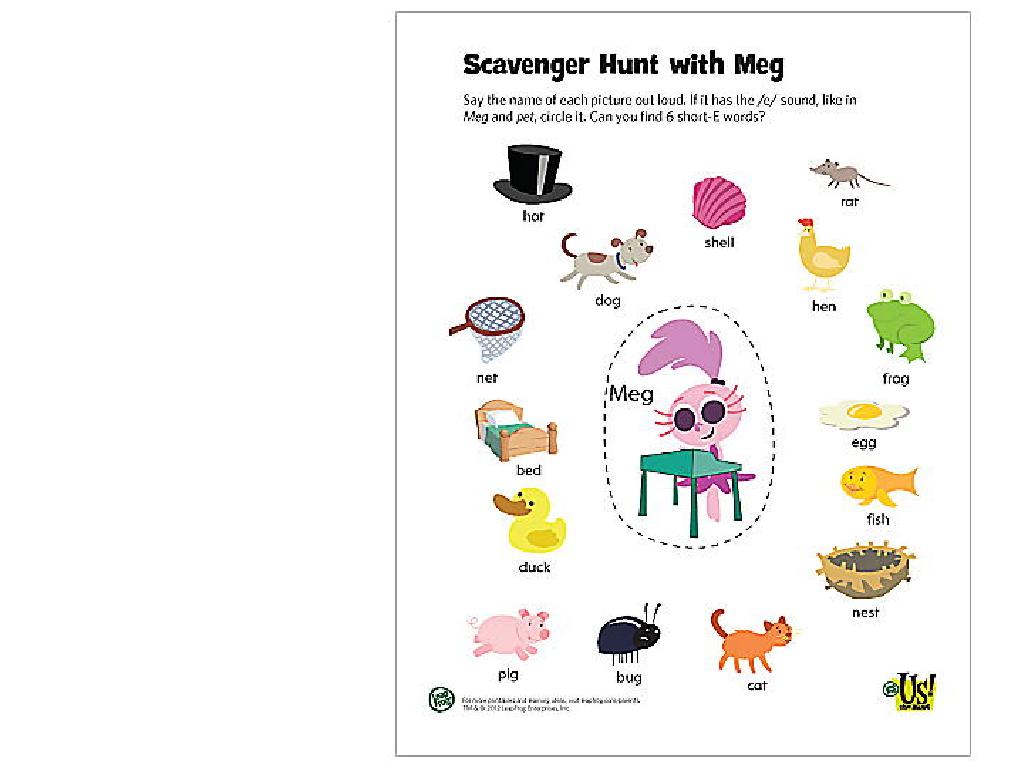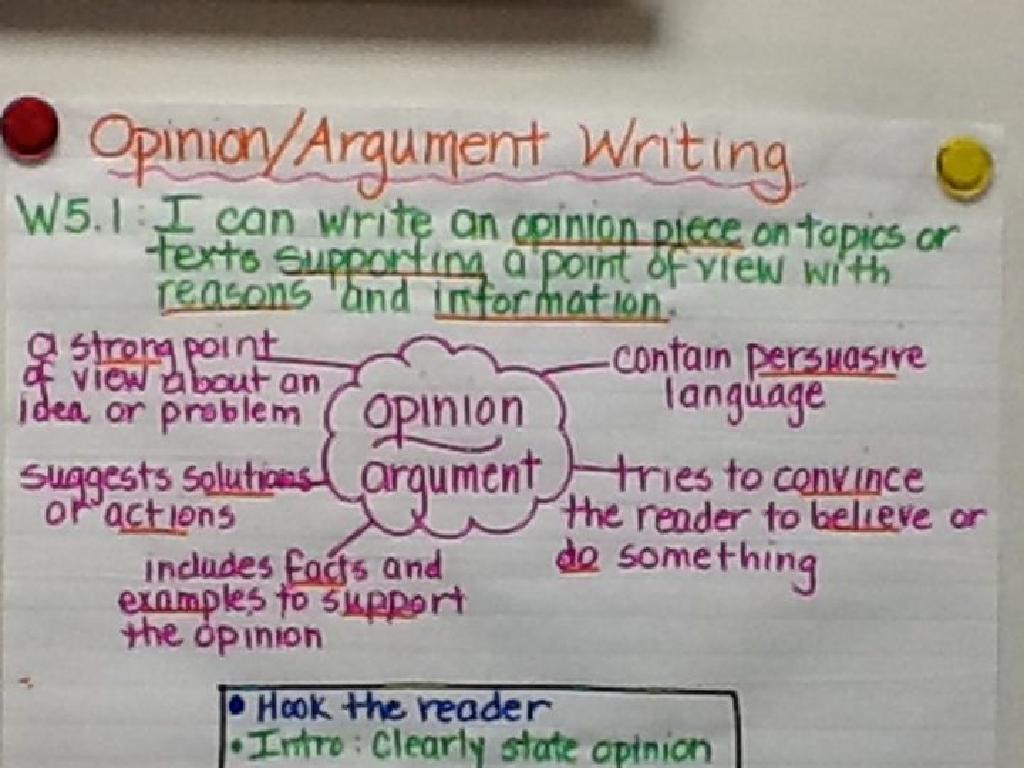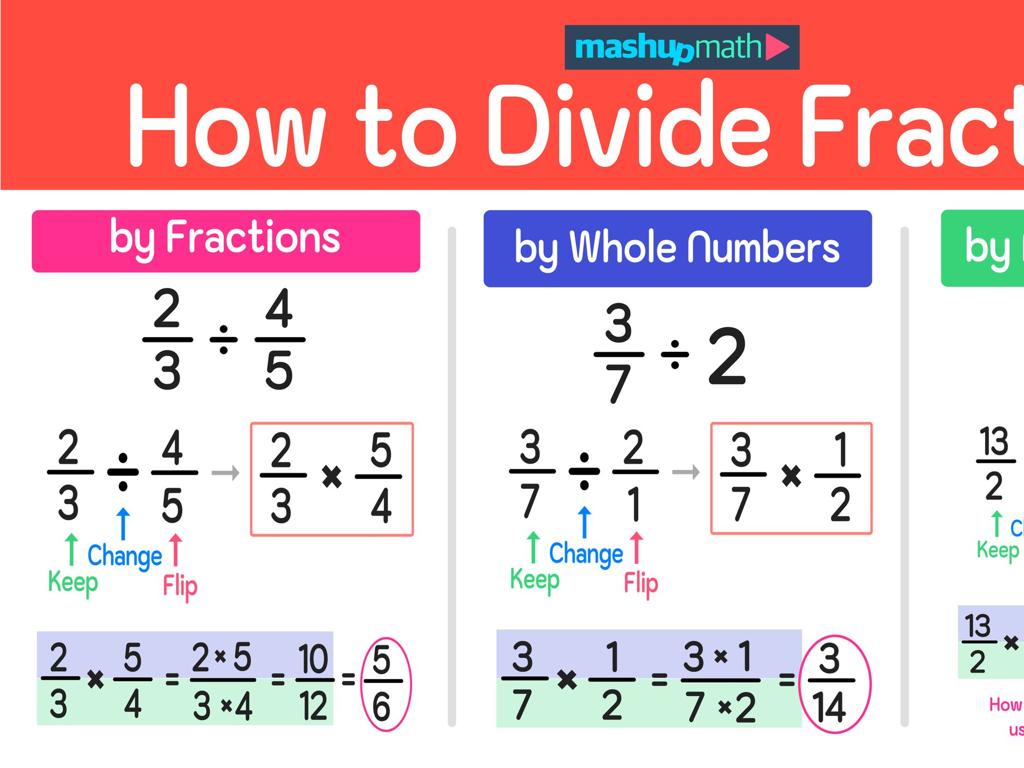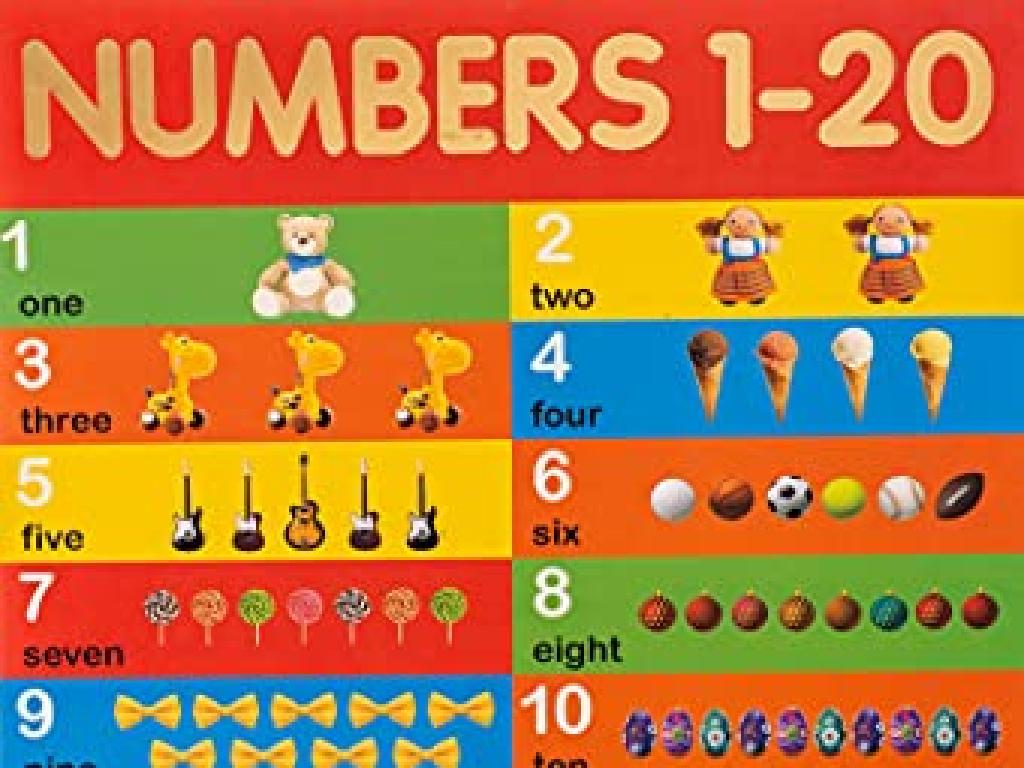Names Of Numbers - Up To 10
Subject: Math
Grade: Kindergarten
Topic: Numbers To 10
Please LOG IN to download the presentation. Access is available to registered users only.
View More Content
Welcome to Numbers!
– Greetings, young mathematicians!
– Today’s focus: Numbers 1 to 10
– We’ll learn to recognize and say numbers 1 through 10
– Numbers are fun and all around us
– Look around, numbers are in clocks, on phones, and more
– Let’s count and explore together
– We’ll use games and objects to count up to 10
|
This slide is designed to introduce kindergarten students to the concept of numbers, specifically numbers up to 10. Start the lesson with a warm and engaging greeting to capture the children’s attention. Emphasize that numbers are not just a part of math class; they are a part of everyday life. Use real-world examples that children can relate to, such as counting toys, snacks, or even steps. Incorporate interactive activities such as counting along with a song or using fingers to represent numbers. The goal is to create a fun and educational environment where the children can begin to understand and recognize numbers 1 through 10.
What Are Numbers?
– Numbers help us count
– Like counting apples or toys
– Numbers show how many
– If you have 3 cookies, that’s the number 3
– Starting with number 1
– Number 1 is the first number we learn
– Practice counting to 10
|
This slide introduces the concept of numbers to Kindergarten students. Begin by explaining that numbers are tools we use to determine how many items we have, such as toys or cookies. Emphasize that numbers are everywhere and we use them every day. Start with the number 1, as it is the beginning of learning to count. Encourage the children to practice counting from 1 to 10 with you, using their fingers or objects in the classroom. This activity will help them understand the sequence of numbers and the concept of counting. Make the session interactive by asking them to count various items in the classroom.
Learning the Number 1
– The number one: 1
– Number 1 is the first counting number
– Counting single items
– Say ‘1’ when there’s only one item
– One toy, one apple
– Example: 1 balloon, 1 cookie
– Number 1 in our lives
|
This slide introduces the concept of the number 1 to Kindergarten students. It’s important to emphasize that the number 1 is used to count one single item, whether it’s a toy, an apple, or any other object. Use real-life examples that the children can relate to, such as one of their toys or a piece of fruit. Encourage the students to practice counting one item at a time to reinforce the concept. Activities can include identifying one object in the classroom, or bringing one favorite item from home to share. This will help them understand the concept of ‘one’ and its significance in counting and everyday life.
Counting Numbers 2 to 5
– Counting 2, 3, 4, and 5
– Each number shows quantity
– For example, 2 apples, 3 teddy bears, 4 blocks, 5 crayons
– Practice with real objects
– Use toys or classroom items to count
– Fun counting activities
|
This slide is aimed at helping Kindergarten students understand the concept of numbers 2 to 5 by counting together and associating numbers with quantities. Start by counting out loud from 2 to 5 with the class, using your fingers to visually represent each number. Then, explain that numbers help us know how many things we have, using relatable examples like fruits or toys. Engage the students in a hands-on activity where they can practice counting objects in the classroom, such as blocks or crayons, to reinforce the concept. Incorporate fun counting songs or games to make the learning process enjoyable and memorable. The goal is for students to be able to recognize and count objects within the number range confidently.
Counting Numbers 6 to 10
– Counting from six to ten
– Let’s say: 6, 7, 8, 9, 10 together!
– Numbers help count things
– More numbers mean more objects we can count.
– Practice with items
– Use toys to count: 6 dolls, 7 cars, 8 blocks…
– Number recognition
– Can you point to the number 8?
|
This slide is aimed at helping Kindergarten students become familiar with the numbers 6 to 10. Start by counting together as a class to reinforce number sequence. Explain that understanding these numbers allows us to count more things in the world around us. Engage the students with hands-on counting activities using classroom items or toys to make the learning process interactive and fun. Reinforce number recognition by showing the numbers and asking students to identify them. This will help solidify their understanding of these fundamental math concepts.
Counting Practice: Numbers Up to 10
– Let’s count objects together
– Match objects to numbers
– For example, 3 apples match with the number 3
– Practice with numbers 1 to 10
– Use toys, fingers, or drawings to count
– Have fun with counting!
|
This slide is designed to engage Kindergarten students in a counting activity that helps them associate numbers with quantities. Start by counting familiar objects together in the classroom, such as crayons or blocks. Encourage the children to match the quantity of objects they’ve counted to the correct numeral. Reinforce numbers 1 through 10 by using different objects and visual aids like pictures or number cards. Make the activity interactive and enjoyable by incorporating songs or rhythmic clapping as you count. The goal is to build a strong foundation for number recognition and one-to-one correspondence in a playful and supportive environment.
Number Fun!
– Numbers are exciting!
– Sing along with number songs
– ‘One, Two, Buckle My Shoe’ or ‘Five Little Ducks’
– Play games involving numbers
– ‘Duck, Duck, Goose’ with a counting twist
– Numbers help us count things
|
This slide is designed to introduce Kindergarten students to the joy of numbers through interactive and engaging activities. Emphasize that numbers are not just for math class; they are a part of everyday life and can be a source of fun. Encourage the children to think of numbers as their friends. Introduce them to classic number songs that they can sing along to, which will help them remember the sequence of numbers. Also, suggest playing simple counting games that incorporate movement and music, making the learning process enjoyable. The goal is to create a positive and playful association with numbers, setting a foundation for their mathematical journey.
Class Activity: Number Hunt
– Let’s go on a Number Hunt!
– Find objects in our classroom
– Look for pencils, books, or blocks
– Count each object, up to 10
– Use your fingers to help count
– Ready, set, count!
|
This interactive activity is designed to help Kindergarten students practice counting to 10 in a fun and engaging way. Set up the classroom with various objects that the children can easily count. Encourage them to work in pairs or small groups to foster teamwork. As they find objects, guide them to count out loud together. This will not only help with their number recognition but also with their counting skills. Possible variations of the activity could include counting different colored objects, grouping objects by type, or even a timed hunt to add excitement. Remember to praise their efforts and make sure each child participates and practices their counting.






